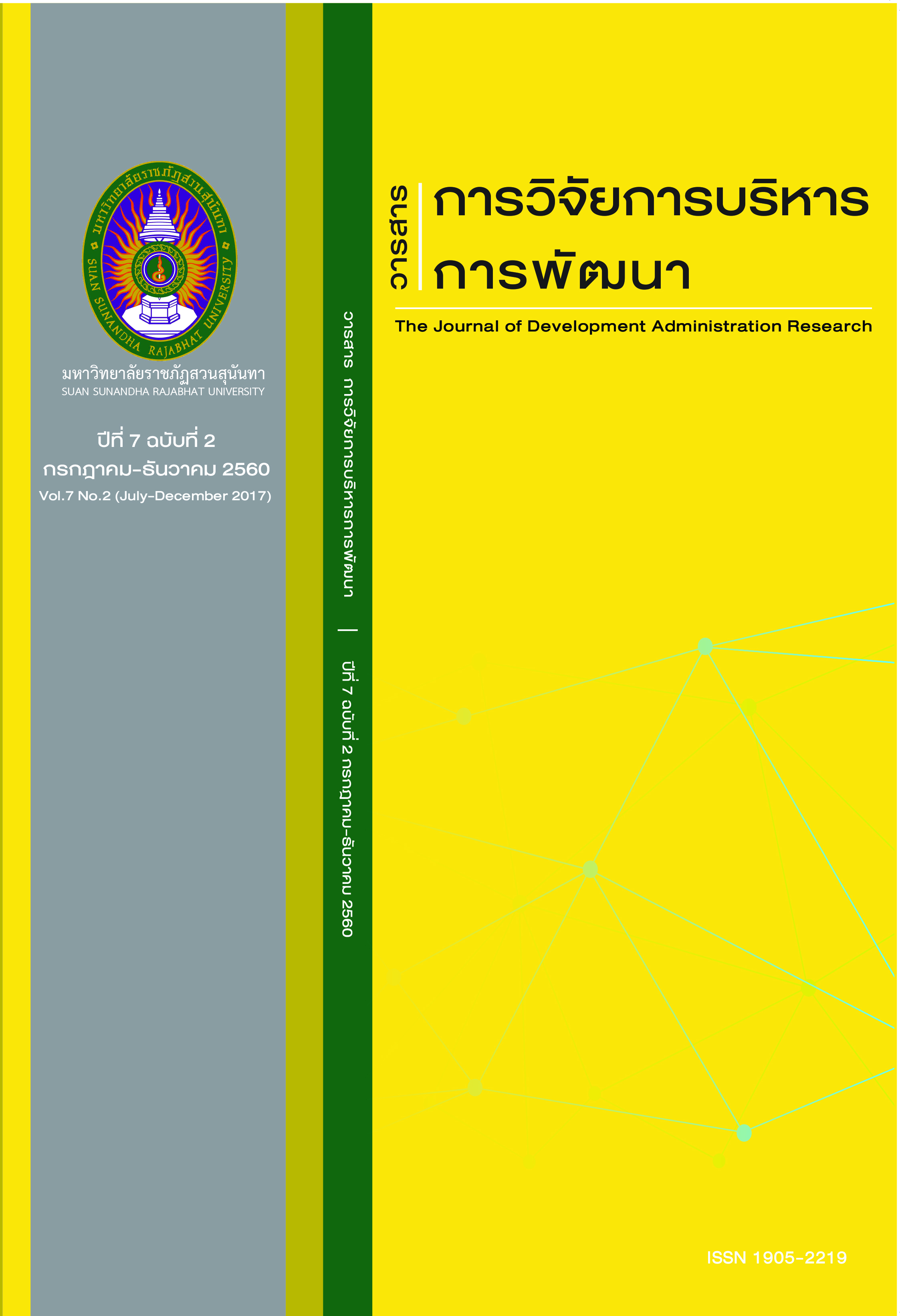อิทธิพลของความเป็นธรรมที่รับรู้ และความคาดหวังของผู้บริโภค ที่มีผลต่อประสิทธิผลในการคุ้มครองผู้บริโภค
คำสำคัญ:
ความเป็นธรรมที่รับรู้, ความคาดหวังของผู้บริโภค, ประสิทธิผลในการคุ้มครองผู้บริโภคบทคัดย่อ
การวิจัยนี้มีวัตถุประสงค์เพื่อศึกษาอิทธิพลของความเป็นธรรมที่รับรู้ และความคาดหวังของผู้บริโภคที่มีผลต่อประสิทธิผลในการคุ้มครองผู้บริโภค เก็บรวบรวมข้อมูลและวิเคราะห์มูลในเชิงปริมาณ การวิจัยครั้งนี้ประชากรคือ ผู้บริโภคที่มาร้องเรียน ณ สำนักงานคณะกรรมการคุ้มครองผู้บริโภค จำนวน 400 ราย โดยจำแนกเป็นข้อร้องเรียนประเภทบริการ สินค้าอุปโภคและบริโภค และอสังหาริมทรัพย์ เก็บรวบรวมข้อมูลโดยใช้แบบสอบถาม วิเคราะห์ข้อมูลโดยใช้อัตราส่วนร้อยละ ค่าเฉลี่ย ค่าส่วนเบี่ยงเบนมาตรฐาน ค่าต่ำสุด ค่าสูงสุด และใช้การวิเคราะห์สมการเชิงโครงสร้าง ผลการวิจัยพบว่า (1) ผู้บริโภคมีความคิดเห็นในเรื่องความยุติธรรมตามการมีปฏิสัมพันธ์ระหว่างกันสำคัญที่สุด รองลงมาคือ ความยุติธรรมตามกระบวนการ และความยุติธรรมตามการได้รับผลตอบแทน (2) ผู้บริโภคมีความคาดหวังในคุณภาพการบริการมากที่สุด รองลงมาคือ ความคาดหวังการตอบสนองขององค์กร และความคาดหวัง ที่จะได้รับการเยียวยา (3) ผู้บริโภคเห็นว่าสำนักงานคณะกรรมการคุ้มครองผู้บริโภคมีภาพลักษณ์ที่ดีอยู่ในระดับมากและ มีความเชื่อมั่นในสำนักงานคณะกรรมการคุ้มครองผู้บริโภคระดับมากเช่นกัน ส่วนในด้านความพึงพอใจของผู้บริโภคมีความพึงพอใจระดับปานกลาง (4) ความเป็นธรรมที่รับรู้ และความคาดหวังของผู้บริโภค เป็นปัจจัยที่ส่งผลต่อประสิทธิผลในการคุ้มครองผู้บริโภค
เอกสารอ้างอิง
สุชาติ ประสิทธิ์รัฐสิทธิ์, กรรณิการ์ สุขเกษม, โศภิต ผ่องเสรี และถนอมรัตน์ ประสิทธิเมตต์. (2551). แบบจำลองสมการโครงสร้าง การใช้โปรแกรม LISREL, PRELIS และ SIMPLIS (เทคนิคการวิเคราะห์เชิงปริมาณที่กำลังเป็นที่นิยมกันมาก). กรุงเทพฯ: สามลดา.
สำนักงานคณะกรรมการคุ้มครองผู้บริโภค. (2556ก). ประวัติความเป็นมา. สืบค้นเมื่อ มีนาคม 17, 2558, จาก http://www.ocpb.go.th/wet_news.php?nid=7
สำนักงานคณะกรรมการคุ้มครองผู้บริโภค. (2556ข). สิทธิผู้บริโภค 5 ประการ. สืบค้นเมื่อ มีนาคม 17, 2558, จาก http://www.ocpb.go.th/wet_news.php?nid=35
สำนักงานคณะกรรมการคุ้มครองผู้บริโภค. (2556ค). ภาระและอำนาจหน้าที่. สืบค้นเมื่อ มีนาคม 15, 2558, จาก http://www.ocpb.go.th/wet_news.php?nid=11
Abbas, M., Abdullateef, A., & Mokhtar, S. (2015). Does service recovery lead to customer satisfaction and loyalty in airline industry? A perceived justice theory approach. World Applied Sciences Journal, 33(2), pp. 256-262.
Bolton, R. N., & Drew, J. H. (1991). A multistage model of customers’ assessments of service quality and value. Journal of Consumer Research, 17(4), pp. 375-384.
Chung, K., Yu, J., Choi, M., & Shin, J. (2015). The effects of CSR on customer satisfaction and loyalty in China: The moderating role of corporate image. Journal of Economics, Business and Management, 3(5), pp. 542-547.
Coye, R. W. (2004). Managing customer expectation in the service encounter. International of Service Industry Management, 15(1), pp. 54-71.
Cronin, J. J., & Taylor, S. A. (1992). Measuring service quality: A reexamination and extension. Journal of Marketing, 56, pp. 55-68.
Crosby, L. A., Evans, K. A., & Cowles, D. (1990). Relationship quality in services selling: An interpersonal influence perspective. Journal of Marketing, 54(July), pp. 68-81.
del Rio-Lanza, A. B., Vazquez-Casielles, R., & Diaz-Martin, A. M. (2009). Satisfaction with service recovery: Perceived justice and emotional responses. Journal of Business Research, 62(8), pp. 775-781.
Dobni, D., & Zinkhan, G. M. (1990). In search of brand image: A foundation analysis. Advance in Consumer Research, 17(1), pp. 110-119.
Dowling. G. R. (1986). Managing your corporate images. Industrial Marketing Management, 15, pp. 109-115.
Dwyer, R., Schurr, P., & Oh, S. (1987). Developing buyer-seller relationships. Journal of Marketing, 51, pp. 11-27.
Fierro, J., Pineda, J., Denitez, R., & Carrasco, R. (2011). Does the customers’ educational level moderate service recovery processes? International Journal of Business and Social Science, 2(21), pp. 59-71.
Friedman, R., & Lesig, V. P. (1987). Psychological meaning of product positioning. Journal of Product Innovation Management, 4(4), pp. 265-273.
Gabarino, E., & Johnson, M. S. (1999). The different roles of satisfaction, trust, and commitment in customer relationships. The Journal of Marketing, 63, pp. 70-87.
Gronroos, C. (1994). From marketing mix to relationship marketing: Towards a paradigm shift in marketing. Manager Decision, 32(2), pp. 4-20.
Hagen, J. M., & Choe, S. (1998). Trust in Japanese interfirm relations: Institutional sanctions matter. The Academy of Management Review, 23(3), pp. 589-600.
Hart, C., Heskett, J., & Sasser, W. E. (1990). The profitable art of service recovery. Harvard Business Review, 4(68), pp. 148-156.
Harris, K. E., Grewal, D., Mohr, L. A., & Bernhardt, K. L. (2006). Consumer responses to service recovery strategies: The moderating role of online versus offline environment. Journal of Business Research, 59(4), pp. 425-431.
Hess, R. L. Jr., Ganesan, S., & Klien, N. M. (2003). Service failure and recovery: the impact of relationship factors on consumer satisfaction. Journal of the Academy of Marketing Science, 31(2), pp. 127-145.
Hoffman, K. D., & Kelly, S. w. (2000). Perceived Justice needs and recovery evaluation: a contingency approach. European Journal of Marketing, 34(3/4), pp. 418-433.
Hsieh, Y., Yuan, S., & Kuo, R. (2011). A PSO-based intelligent service dispatching mechamism for customer expectation management. Expert System with Applications, 38, pp. 12128-12141.
Huang, W. H. (2008). The impact of other-customer failure on service satisfaction. International Journal of Service Industry Management, 19(4), pp. 521-536.
Kim, T., Kim, W. G., & Kim, H. B. (2009). The effects of perceived justice on recovery satisfaction, trust, word-of-mouth and revisit intention in upscale hotels. Tourist Management, 30(1), pp. 51-62.
Kline, R. B. (2005). Plinciple and practice of structural equation modeling. New York: Guilford.
Kotler, P., & Pfoertsch, W. (2006). B2B brand management. New York: Springer.
Kutz, D. L., & Clow, K. E. (1992). Managing consumer expectations of services. The Journal of Marketing Management, 42, pp. 19-25.
Martinez, E., & Pina, J. (2003). The negative impact of brand extensions on parent brand image. Journal of product and brand management, 12(7), pp. 432-448.
Martinea-Tur, V., Peiro, J., Ramos, J., & Moliner, C. (2006). Justice perceptions as predictors of customer satisfaction: The impact of distributive, procedural and interactional justice. Journal of Applied Social Psychology, 36(1), 100-119.
Mattila, A. S. (2001). The effectiveness of service recovery in a multi-industry setting. Journal of Service Marketing, 5(7), pp. 583-596.
Nikbin, D. & Ismail, I. (2010). Perceived justice in service recovery and recovery satisfaction: The moderating role of corporate image. Journal of Marketing, 2(2), pp. 47-56.
Nikbin, D., Jsmail, I., Marimuthu, M., & Asmesh, H. (2012). Perceived justice in service recovery and switching intention: Evidence from Malaysian mobile telecommunication industry. Management Research Review, 35(3/4), pp. 309-325.
Parasuraman, A., Zeithaml, V. A., & Berry, L. L. (1988). SERVQUAL: A multiple-item scale for measuring customer perceptions of service quality. Journal of Retailing, pp. 12-40.
Parasuraman, A., Zeithaml, V. A., & Berry, L. L. (1990). Delivering quality service-balancing customer perceptions and expectations. New York: The Free Press.
Priluck, R., & Lala, V. (2009). The impact of the recovery paradox on retailer-customer relationships. Managing Service Quality, 19(1), pp. 42-59.
Rotter, J. B. (1971). Generalized expectancies for interpersonal trust. American Psychologist, 26(5), pp. 443-452.
Schoorman, F. D., Meyer, R. C., & Devis, J. H. (2007). An integrative model of organizational trust: Past, present, and future. Academy of Management review, 32(2), pp. 344-354.
Smith, A. K., Bolton, R. N., & Wagner, J. (1999). A model of customer satisfaction with service encounters involving failure and recovery. Journal of Marketing Research, 36(3), pp. 356-372.
Sparks, B. A., & McColl-Kennedy, J. R. (2001). Justice strategy options for increased customer satisfaction n a services recovery setting. Journal of Business Research, 54(3), pp. 51-62.
Tax, s. S., & Brown, S. W. (2000). Service recovery: Research insights and practices. In T. Swartz & D. Iacobucci. (Eds.), Handbook of Services Marketing and Management. Thousand Oaks, California: Sage.
Tse, D. K., & Wilson, P. C. (1988). Models of consumer satisfaction formation: An extension. Journal of Marketing Research, 25, pp. 204-212.
Weiner, B. (2000). Attributional thoughts about consumer behavior. Journal of Consumer Research, 24(3), pp. 382-387.
Yi, Y., & Lee, J. (2005). An empirical study on the customer responses to service recovery in the context of service failure. Seoul Journal of Business, 11(1), pp. 1-17.
Zeithaml, V. A., Parasuraman, A., & Berry, L. L. (2009). Delivering quality service-balancing customer perceptions and expectations. New York: The Free Press.
ดาวน์โหลด
เผยแพร่แล้ว
รูปแบบการอ้างอิง
ฉบับ
ประเภทบทความ
สัญญาอนุญาต
บทความที่ได้รับการตีพิมพ์เป็นลิขสิทธิ์ของมหาวิทยาลัยราชภัฏสวนสุนันทา
ข้อความที่ปรากฏในบทความแต่ละเรื่องในวารสารวิชาการเล่มนี้เป็นความคิดเห็นส่วนตัวของผู้เขียนแต่ละท่านไม่เกี่ยวข้องกับมหาวิทยาลัยราชภัฏสวนสุนันทา และคณาจารย์ท่านอื่นๆ ในมหาวิทยาลัยฯ แต่อย่างใด ความรับผิดชอบองค์ประกอบทั้งหมดของบทความแต่ละเรื่องเป็นของผู้เขียนแต่ละท่าน หากมีความผิดพลาดใดๆ ผู้เขียนแต่ละท่านจะรับผิดชอบบทความของตนเองแต่ผู้เดียว




